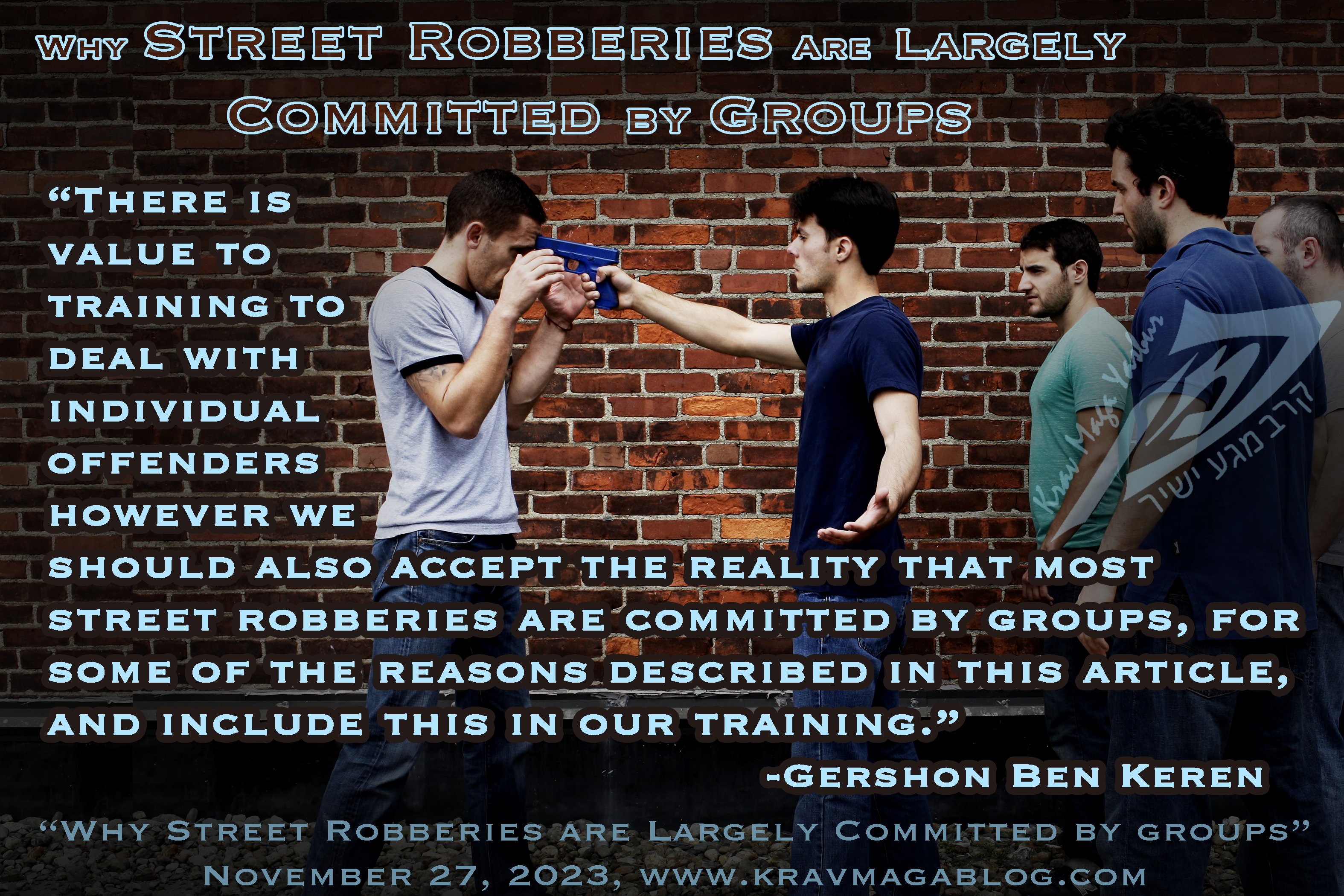Author: Gershon Ben Keren

One of the consistent findings about street robberies/muggings, is that it appears statistically that most involve more than one offender; something that is often not reflected in self-defense and Krav Maga training. Whilst not every potential gun or knife threat is going to be in the context of a street robbery, when we look at the situations most people are going to find themselves in this is one of the most likely scenarios e.g., a person is more likely to be targeted for a mugging than an abduction, and in most forms of social violence – unless you live in a certain locale – your aggressor is unlikely to be armed etc. Context is often lost in training, with techniques being practiced as choreographed movements rather than as solutions to defined and identifiable situations. Whenever looking at research and statistics it is always worth noting that with official records and reporting, such as with police incident reports, there is the potential for both under-reporting crime e.g., someone who is robbed by a single mugger may feel a sense of shame that they were unable to deal with their aggressor and therefore not report the incident, whilst if they are threatened by a group they may feel less likely to be judged for acquiescing and handing over their assets and so report the offense. This is why it is always useful to compare such official statistics and findings, which support the idea that most street robberies are committed by multiple assailants, with self-report studies which have those who commit these offenses describe and give accounts of how they go about committing their crimes etc. In this article I want to look at some of the reasons why most street robberies involve more than one offender, as this may seem to some people as counter-intuitive e.g., whatever is taken has to be divided up meaning each mugger has to give up and share rather than keep all the money and/or goods for themselves.
One of the things that just about all criminologists agree on is that crime is a young person’s game, and more specifically a young male game. When offense data is aggregated offending rapidly declines as people enter their early/mid-twenties. When we consider our own teenage years, we probably spent much more time with others than we do now. That was certainly true of my life. A good percentage of it was spent with friends, as part of a group, in public spaces i.e., away from the home and parents etc. This is largely true of young offenders who are responsible for the majority of muggings and street robberies. If we look on street robberies as being largely opportunistic affairs, whilst there may be a primary offender who initiates the incident, it is likely that they have other people with them who have varying degrees of willingness, simply because socializing with others is part of their routine activities. Single offender incidents often occur where the offender is older, and/or the offender has an immediate need for cash, such as needing to acquire drugs etc. An individual committing a street robbery as part of a group means that others see them in action, which increases their social standing in the group, gaining them respect and reinforcing their own self-image and identity. Elijah Anderson who wrote, “The Code of the Street”, and who conducted ethnographic studies in socially and economically deprived communities, wrote about how in the absence of material wealth “respect” became a valuable commodity that young men wanted to acquire. In the UK, street robbery and mugging is often referred to as “taxing”, by those who commit these offenses e.g., people who walk on the streets of their community have to pay a tax to do so. Collecting such a tax puts the individual in a position of power and control that in line with the values of the group gains them respect and status. It also bonds the group and helps to create a social identity.
Numbers improve the chances of a target acquiescing to the demand. A confident, fit individual may believe they have the physical abilities to take on one individual, however as numbers increase this belief is likely to decrease. In one 2007 study, offenders acknowledged that there was little a victim could do to prevent a robbery occurring, especially when those targeted were dealing with multiple offenders. If those targeted did try to resist and fight back the outcome was usually bad for the individual, and they usually ended up giving up their assets. As one respondent in the study recalled, “A guy near here, I think he was a businessman he fought for his shit, so, he weren’t giving it up, so we had him for about 15 minutes, just punching the fuck out of him, he weren’t giving it up, he gave it up in the end.” Numerical superiority in a violent confrontation is a serious advantage. It also allows for the absence of weapons that could see the offense quickly escalate to a more serious one such as a homicide. This is one of the reasons that most street robberies are “strong arm” affairs i.e., the presence of others as a show of force means that weapons don’t need to be shown and/or used.
In self-report studies and research, a consistent finding is that those who commit street robberies take confidence from co-offending, as they know they’ll have backup, should a target offer resistance. It also allowed the sharing of knowledge and expertise, that improved a mugger’s education of how to commit street robberies. When we train to deal with mugging scenarios, we should try to replicate the different components present in such incidents. There is value to training how to deal with individual offenders however we should also accept the reality that most street robberies are committed by groups, for some of the reasons described in this article, and include this into our training.